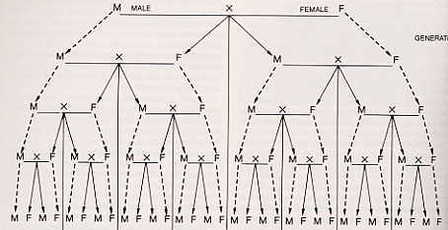Line Breeding
The following is an article written by Dr Charles R H Everett & Craig Russell, the subjest matter is in relation to breeders who were involved in cock fighting (appologies about that), but this principle can be applied to any breed. Something that may be useful to anyone working with limited numbers of the Ayam Cemani.

My personal research in breeding has led me to begin gathering and collecting articles and books by cockfighters (cockers) of long ago; these men of the past preserved several different breeds of chickens for hundreds possibly even thousands of years. During that time they maintained type and vigor to an unparallel degree. It is my belief that their methods of breeding should be examined in detail to be utilized by the modern preservationist. Let me add, however, that this article is not an endorsement or defense of cockfighting; neither will I belie them in any manner. Instead, it is a heartfelt acknowledgement to men who perfected the art of breeding chickens. Further, I believe the modern preservationist can learn much more from the breeding techniques of cockers than he/she can from textbooks on commercial poultry breeding. (Note* It should go without saying that at all times you must select for vigor and type regardless of the breeding system utilized. Cocker Tan Bark states, “Good breeding is only a matter of intelligent selection of brood fowl…” (Tan Bark, Game Chickens and How to Breed Them, 1964, p. 27). What the ole time cockers strove for was prepotency. They desired to be able to predict with reasonable accuracy the outcome of any particular mating. For this reason, no cocker worth his salt would have consistently used the out-and-out system. Granted, at times they did cross, but very carefully. Their records consistently indicate that when they did cross they did so using the same strain of fowl they were hoping to improve. Of course, they were looking for gameness, but using their methods a breeder can breed for type, fertility, egg production, etc. The first system I would introduce was utilized by William Morgan, of Morgan Whitehackle fame, and some of the English cockers. It is a form of breeding known as “3 times in and once out.” This system was used to produce, in cockers’ terms, a “pure strain.” The following chart will explain how the system works. First Generation Hen Cock ½ hen ½ cock
Second Generation Hen to son Cock to daughter ¾ hen ¾ cock
Third Generation Hen to grandson Cock to granddaughter 7/8 hen 7/8 cock
Fourth Generation Hen to ggrandson Cock to ggranddaughter 15/16 hen 15/16 cock
Now in the 5th generation you breed the 15/16 hen to the 15/16 cock. Then, choosing the best hen(s) and cock(s) you begin again
Second Generation Hen to son Cock to daughter ¾ hen ¾ cock
Third Generation Hen to grandson Cock to granddaughter 7/8 hen 7/8 cock
Fourth Generation Hen to ggrandson Cock to ggranddaughter 15/16 hen 15/16 cock
Now in the 5th generation you breed the 15/16 hen to the 15/16 cock. Then, choosing the best hen(s) and cock(s) you begin again
